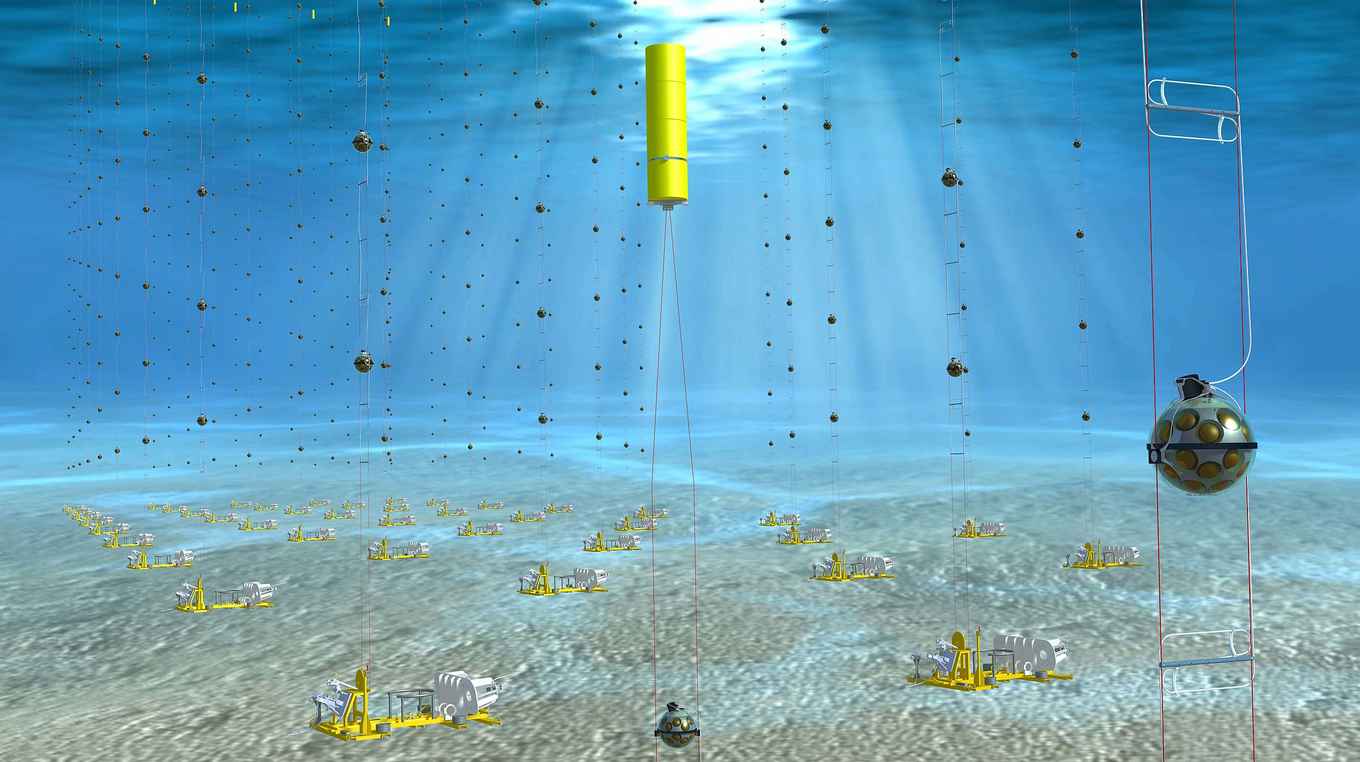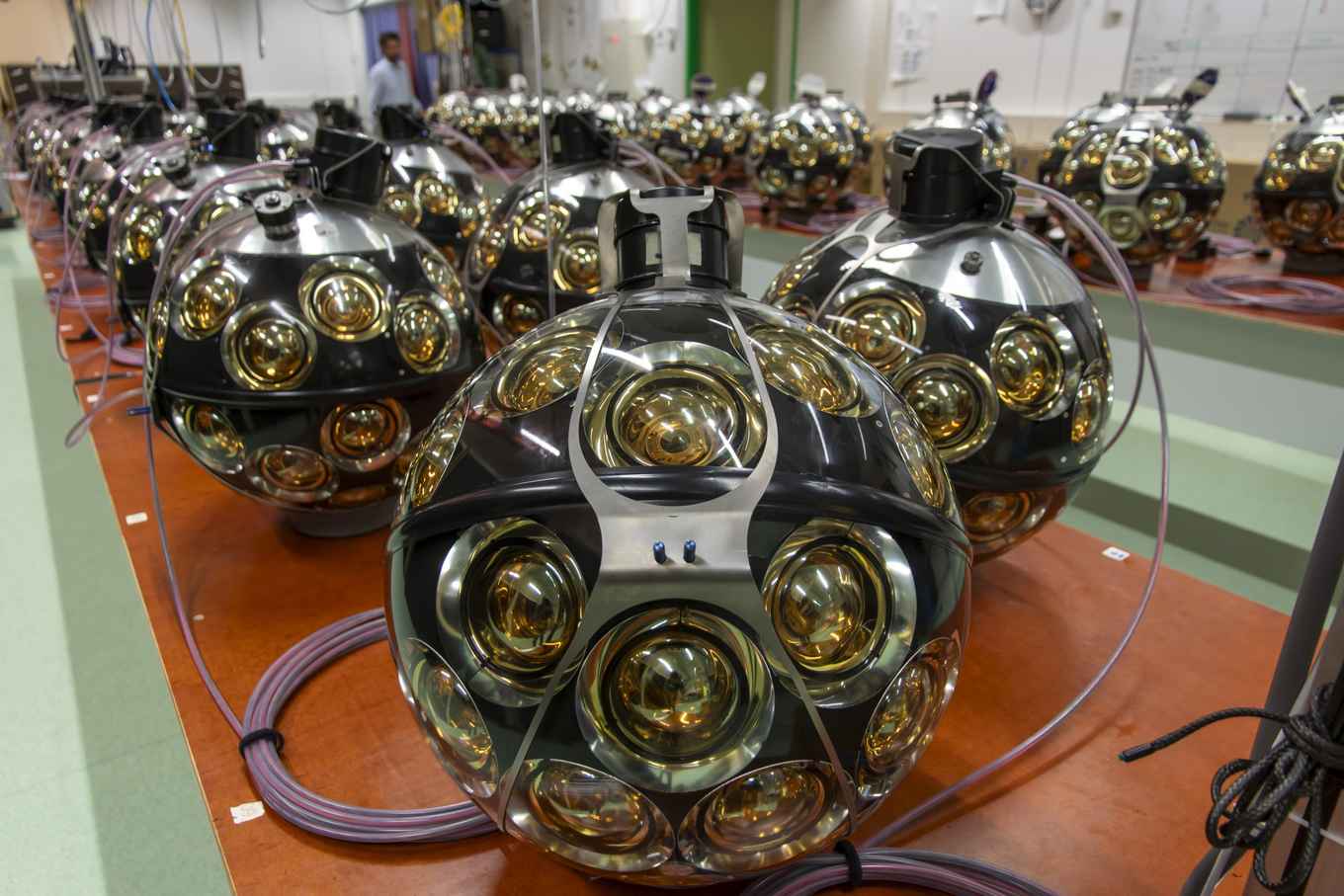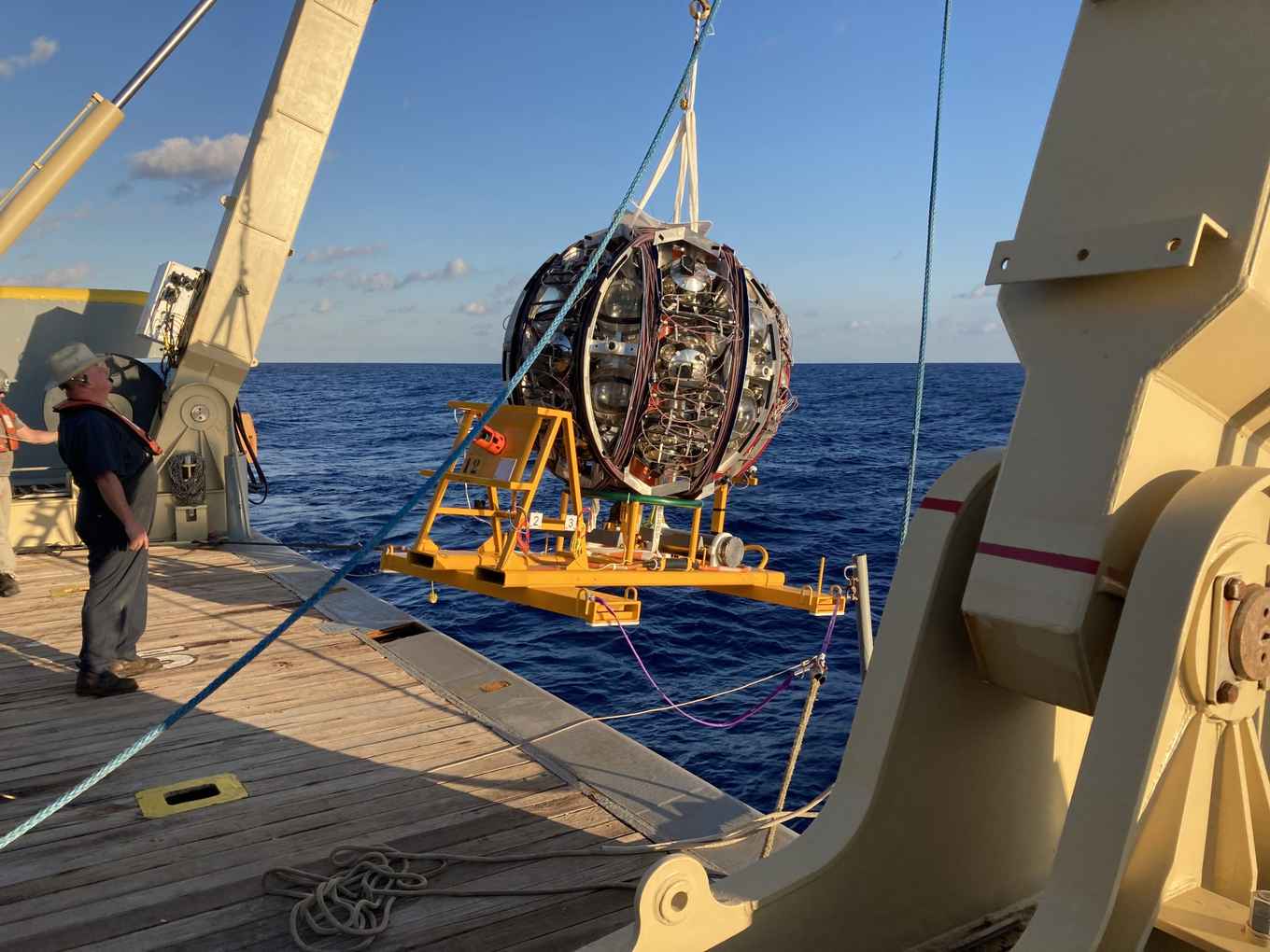KM3NeT detects highest energy neutrino ever
12 February 2025

An extraordinary signal, corresponding to a neutrino with an energy of about 220 PeV – 220 x 1015 electron volts or 220 million billion electron volts. This was detected by the ARCA detector of the ‘cubic kilometre neutrino telescope’ (KM3NeT) on 13 February 2023 in the deep sea. This measurement, called KM3-230213A, is the most energetic neutrino ever observed. The measurement provides the first evidence that neutrinos with such high energies are produced in the universe. After lengthy and meticulous analysis and interpretation of the experimental data, an article was published in Nature today. In it, the international scientific KM3NeT collaboration reports on the details of this fantastic discovery.
The detected signal appears to have come from a single muon that has traversed the entire detector, generating signals in more than one third of the active sensors. The inclination of the trajectory, combined with the enormous energy, provides compelling evidence that the muon came from a cosmic neutrino interacting in the vicinity of the detector.
“KM3NeT has started to explore an energy and sensitivity range where detected neutrinos may originate from extreme astrophysical phenomena. This first-ever detection of a neutrino of hundreds of PeVs opens a new chapter in neutrino astronomy and a new observational window on the Universe,” said Paschal Coyle, KM3NeT spokesperson at the time of the detection and researcher at CNRS Centre National de la Recherche Scientifique – Centre de Physique des Particules de Marseille, France.
Ultra high energy
The high-energy universe is the domain of extreme events, such as the formation of supermassive black holes at the centres of galaxies, supernova explosions, and gamma-ray bursts. These powerful cosmic accelerators generate streams of particles called cosmic rays that travel through the universe. Some cosmic rays interact with matter or photons around the source, producing neutrinos and photons. As the most energetic cosmic rays travel through the universe, some of them may also interact with photons from the cosmic microwave background. In this case, they produce extremely energetic cosmogenic neutrinos.
There are several potential origins for the ultrahigh-energy neutrino that was measured. It is possible that the neutrino came directly from a powerful cosmic accelerator. But it could also be the first detection of a cosmogenic neutrino. However, it is difficult to draw conclusions about the origin based on this single neutrino. Future observations will focus on detecting more such events to get a clearer picture. The continued expansion of KM3NeT with additional detection units and the collection of additional data will improve the sensitivity and increase the ability to localize cosmic neutrino sources. This will contribute to so-called ‘multi-messenger astronomy’ in a major way.
“Neutrinos are among the most mysterious elementary particles. They have no electric charge, almost no mass and only weakly interact with matter. They are special cosmic messengers that give us unique information about the mechanisms involved in the most energetic phenomena, and allow us to explore the farthest reaches of the Universe,” explains Rosa Coniglione, KM3NeT deputy spokesperson at the time of the detection, and researcher at the INFN National Institute for Nuclear Physics, Italy.

Detecting Neutrinos with KM3NeT
After photons, neutrinos are the most abundant particles in the universe. However, their weak interaction with matter makes them very difficult to detect, requiring huge detectors. The KM3NeT neutrino telescope currently under construction is a gigantic deep-sea infrastructure divided between two detectors, ARCA and ORCA. In its final configuration, KM3NeT will occupy a volume of more than a cubic kilometre. KM3NeT uses seawater as the interaction medium for neutrinos. Its high-tech optical modules detect Cherenkov light: a bluish glow generated when ultra-relativistic particles produced in neutrino interactions propagate through the water.
“Determining the direction and energy of this neutrino required precise calibration of the telescope and advanced track reconstruction algorithms. Furthermore, this remarkable detection was achieved with only one tenth of the final detector configuration. This demonstrates the great potential of our experiment for studying neutrinos and for neutrino astronomy,” says Aart Heijboer, KM3NeT Physics & Software Manager at the time of the detection, Nikhef researcher and professor at the University of Amsterdam.
Dutch scientists and technicians
Dutch scientists and technicians are closely involved in this special discovery. From the Netherlands, Nikhef, NWO-I, the University of Amsterdam, Leiden University, NIOZ and TNO are members of the KM3NeT collaboration. The institutes have various leadership positions within the collaboration, and are working on the design, construction and placement of the detector, system engineering, software development and the final analysis of the data.
“What a beautiful observation. This is promising for the future of this research field. I look forward to the coming years in which KM3NeT will be expanded. The fact that our researchers and technicians are involved in so many parts of this submarine telescope shows the strength of the Nikhef collaboration in which theory, experiment and instrumentation come together,” says Jorgen D’Hondt, director of Nikhef.
Dorothea Samtleben, program leader of the Nikhef neutrino group and affiliated with Leiden University, adds: “The excellent diverse expertise and years of experience of the Nikhef neutrino group together with the excellence of the Nikhef workshop form a unique and fruitful combination. This allows us to make a significant contribution to the KM3NeT collaboration in many different areas - from detector construction to complex reconstruction algorithms - and also to provide inspiration to many young researchers, engineers and technicians.”
“Building a neutrino telescope on the bottom of the Mediterranean Sea can only be achieved through close international collaboration. You need the groundbreaking knowledge of many different experts, who together build on a shared vision. I am extremely proud of our consortium and the result published today,” says Paul de Jong, KM3NeT spokesperson, vice-program leader of the Nikhef neutrino group and professor at the University of Amsterdam.

The KM3NeT detectors
The KM3NeT/ARCA detector (Astroparticle Research with Cosmics in the Abyss) is primarily dedicated to studying the highest-energy neutrinos and their sources in the Universe. The detector is located at a depth of 3,450 m, about 80 km off the coast of Portopalo di Capo Passero, Sicily. The 700 m high Detection Units (DUs) are anchored to the seabed and are spaced about 100 m apart. Each DU is equipped with 18 Digital Optical Modules (DOMs), each containing 31 photomultipliers (PMTs). In its final configuration, ARCA will comprise 230 DUs. The data collected will be transmitted via a deep-sea cable to the onshore station at the INFN Laboratori Nazionali del Sud.
The KM3NeT/ORCA detector (Oscillation Research with Cosmics in the Abyss) is optimized to study the fundamental properties of the neutrino itself. The detector is located at a depth of 2,450 m, about 40 km off the coast of Toulon, France. It consists of 115 DUs, each 200 m high and spaced 20 m apart. The data collected by ORCA are sent to the land station at La Seyne Sur Mer.
The KM3NeT collaboration brings together more than 360 scientists, engineers, technicians and students from 68 institutions in 21 countries worldwide, including the Dutch institutes Nikhef, NWO-I, the University of Amsterdam, Leiden University, NIOZ and TNO.